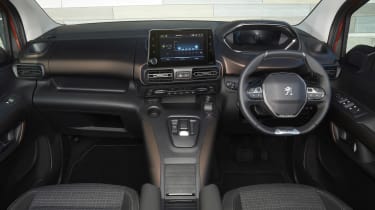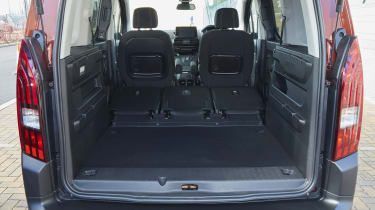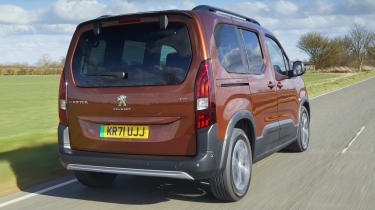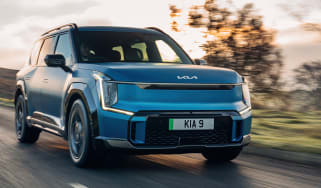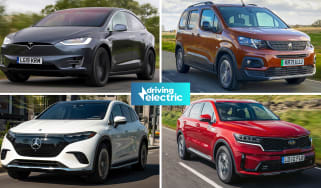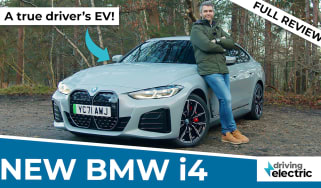Peugeot e-Rifter review
The e-Rifter offers practicality and versatility that few other family cars, electric or otherwise, can match. However, Peugeot’s electric MPV is more expensive than its sister models
Pros
- Impressive practicality
- Spacious and comfortable
- Looks better than its siblings
Cons
- 172-mile range
- Wind noise on the motorway
- Huge tailgate
| Car type | Range | Wallbox charge time | Rapid charge time |
|---|---|---|---|
| Electric | 172 miles | 7hrs 30mins (0-100%, 7.4kW) | 30mins (0-80%, 100kW) |
Peugeot's van-based people carrier is now available exclusively with electric power as the e-Rifter, but that doesn't mean the five or seven-seat MPV is any less versatile than the old petrol and diesel-powered models. This is a great-value option for those with big families or anyone who doesn't want to compromise on practicality by settling for a typical SUV.
The e-Rifter has two mechanically identical sister models: the Citroen e-Berlingo and the Vauxhall Combo-e Life. Under the metal is the same platform and zero-emissions powertrain used by almost all electric cars in the Stellantis family, from the Peugeot e-208 hatchback to the Citroen e-SpaceTourer nine-seater minibus.
The 134bhp electric motor that drives the front wheels is fed by a 50kWh battery, for a claimed driving range of 172 miles and a 0-62mph time of more than 11 seconds. There’s 100kW rapid-charging, so a 0-80% top-up takes 30 minutes from an appropriately fast charging point, while fully replenishing the battery from a standard 7.4kW home wallbox charger takes seven-and-a-half hours.
Peugeot has done a few things to set the e-Rifter apart from its siblings. The styling won’t leave you picking your jaw up off the floor, yet the somewhat muscular touches on the e-Rifter do at least mean it won’t be mistaken for a plumber’s van – unlike its counterpart from Vauxhall. The SUV-esque styling cues on our GT-spec test car, including black cladding and chunky alloys, add a slightly rugged quality to the tall and boxy zero-emissions people carrier.
The most obvious difference in the e-Rifter’s cabin is the small steering wheel, which you look over rather than through to see the Peugeot’s i-Cockpit driver display. This is one of the best uses of the i-Cockpit setup we’ve experienced, because of the already elevated driving position in the e-Rifter. Unlike in some smaller Peugeot models, it works regardless of your height, body type or ideal driving position.
All versions of the e-Rifter get the same 10-inch i-Cockpit digital driver’s display, which is crisp and easy to read, however the eight-inch central touchscreen is laggy and often slow to respond. Apple CarPlay and Android Auto are standard, too, but you’ll need to plug your smartphone in to use either, as there’s no wireless functionality.
There’s a lot of hard plastics around the cabin, but you do get bronze-accented trim on the dashboard and doors, a trove of storage spaces (including an overhead tray) and physical climate controls that are simple to operate on the go. Ultimately, the Peugeot’s cabin isn’t luxurious, but we have no doubt the e-Rifter can stand up to whatever life as a family runabout would throw at it.
Arguably the main reason you’d pick the e-Rifter or one of its sister models over an electric SUV is the vastly superior practicality. The five-seater version we spent time with boasted 775 litres of boot space, which can be expanded to 3,000 litres with the back seats folded down. For those who need even more space, there’s an extended-wheelbase version with seven seats. It’s 350mm longer, so there’s very little compromise for those in the very back, plus you then get 4,000 litres of cargo space with all seven seats down.
On the downside, the huge tailgate can mean accessing the boot in the first place is a struggle, especially in tight or underground car parks. The separately opening rear glass does go some way towards solving this problem, but if you’re trying to load heavier items, lifting them up and through the opening can be difficult.

Thankfully, the Peugeot gets sliding doors as standard that allow for easy, unobstructed access to the rear seats – great if you have to install a child seat. Each rear gets its own set of ISOFIX points, so you can safely fit three child seats across the second row. Frankly, apart from its Citroen and Vauxhall sister models, no electric car offers as much practicality per pound as the e-Rifter.
Surprisingly for such a large car, the e-Rifter is at its best in town or city centres. The small steering wheel and the steering itself being so light mean you can complete manoeuvres with a finger, giving a great sense of agility to the nearly five-metre-long MPV. Plus, visibility all around is great thanks to huge windows, large side mirrors and plenty of parking sensors. The ride is also fairly comfortable, with only the largest bumps and potholes causing the car to fidget.
Unfortunately, the ultra-light steering does become floaty when you’re on the motorway. At higher speeds, the e-Rifter’s boxy shape also creates a huge amount of wind noise, and you’ll also experience a rapid loss in range when travelling at motorway speed, too. While the Peugeot’s rapid-charging capability means you can replenish the battery fairly quickly on a longer journey, if you plan to do them frequently, an SUV like the MG ZS EV or Kia e-Niro may suit you better.
Generally, range was an issue during the week we spent with the e-Rifter, which included a mixture of motorway, town and countryside B-road driving. Over that time, our five-seater model returned an average of 2.7 miles per kilowatt-hour (kWh), which equates to a real-world range of 135 miles at best.
You do get a choice of three power modes – Eco, Normal and Power – but the latter should be reserved for when you’re carrying lots of stuff or people, as using the full 134bhp without it can make the top-heavy minibus feel a bit unwieldy. There’s plenty of oomph from the electric motor when you’re in Normal or even Eco, which limits the power output to 107 and 80bhp respectively. Eco mode ensures you get the most range out of the battery, but it does limit climate-control use.
Both the five and seven-seater versions of the e-Rifter are available in Allure trim, with the former priced at a little over £31,500. These cars get 16-inch alloy wheels, front parking sensors and a 180-degree reversing camera with overhead view, as well as cruise control, lane-keeping assistance, driver attention alert and the previously mentioned eight-inch central touchscreen and 10-inch i-Cockpit digital driver's display.
You can upgrade to GT trim if you stick with the five-seat model; this gets you 17-inch alloys, dual-zone climate control, keyless entry and start and GT styling elements, among other features. Prices for the e-Rifter in GT trim also starts from just under £34,000.
Even if it is a van with windows at the end of the day, there’s no denying that the e-Rifter is an extremely practical, comfortable and spacious electric car that's more relaxing to drive and offers lower running costs than any diesel-powered equivalent. It’s worth a look if you’re in the market for an electric seven-seater for your family or to ferry ride-hailing app customers around town. However, for most people who just want a bit more boot space than your average hatchback, affordable electric SUVs like the MG ZS EV, Skoda Enyaq iV and Hyundai Kona Electric will do the trick, while also offering better refinement and range than the Peugeot.

